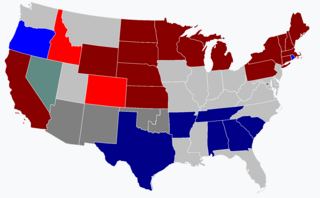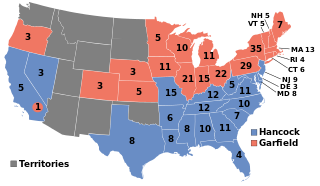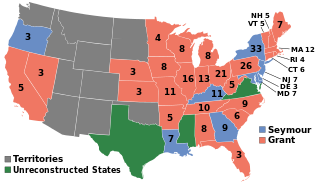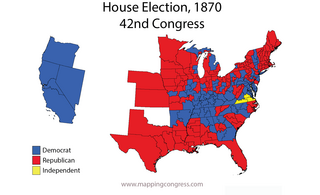
The 1980 United States House of Representatives elections was an election for the United States House of Representatives on November 4, 1980, to elect members to serve in the 97th United States Congress. They coincided with the election of Ronald Reagan as president, defeating Democratic incumbent Jimmy Carter. Reagan's victory also allowed many Republican House candidates to secure elections. The Republicans gained a net of 35 seats from the Democratic Party. The Democrats nonetheless retained a significant majority, unlike the Senate elections, where Republicans gained control of the chamber. However, many Democratic congressmen from the south frequently took conservative stances on issues, allowing Republicans to have a working ideological majority for some of President Reagan's proposals during his first two years in office.

The 1874–75 United States House of Representatives elections were held on various dates in various states between June 1, 1874 and September 7, 1875. Each state set its own date for its elections to the House of Representatives before the first session of the 44th United States Congress convened on December 6, 1875. Elections were held for all 292 seats, representing 37 states.

The 1962 United States elections were held on November 6 to elect the members of the 88th United States Congress. The election occurred in the middle of Democratic President John F. Kennedy's term. The Republican Party picked up four seats in the House of Representatives, but the Democrats retained strong majorities in both houses of Congress. In the Senate, Democrats won a net gain of four seats from the Republicans, maintaining control of the Senate. In the gubernatorial elections, neither party won a net gain of seats. Notably, 1960 Republican presidential nominee Richard Nixon lost the California gubernatorial election, which many analysts, as well as Nixon himself, incorrectly predicted to be the end of his political career.

The 2008 United States elections were held on November 4. Democratic Senator Barack Obama of Illinois won the presidential election, by defeating his challenger, Senator John McCain, and the Democrats bolstered their majority in both Houses of Congress.

The 1996 United States elections were held on November 5. Democratic President Bill Clinton won re-election, while the Republicans maintained their majorities in both houses of the United States Congress.

The 1874–75 United States Senate elections were held on various dates in various states. As these U.S. Senate elections were prior to the ratification of the Seventeenth Amendment in 1913, senators were chosen by state legislatures. Senators were elected over a wide range of time throughout 1874 and 1875, and a seat may have been filled months late or remained vacant due to legislative deadlock. In these elections, terms were up for the senators in Class 1.

The 1902 United States elections elected the 58th United States Congress, and occurred in the middle of Republican President Theodore Roosevelt's first term, during the Fourth Party System. Roosevelt had become president on September 14, 1901, upon the assassination of his predecessor, William McKinley. Republicans retained a majority in both chambers of Congress, while the Populist Party and Silver Republican Party disappeared from Congress.

The 1898 United States elections occurred in the middle of Republican President William McKinley's first term, during the Fourth Party System. The elections took place shortly after the Spanish–American War. Members of the 56th United States Congress were chosen in this election. Republicans retained control of both houses of Congress.

The 1880 United States elections occurred during the Third Party System, and elected the members of the 47th United States Congress. Republicans retained the Presidency and took control of the House. An unclear partisan situation prevailed in the Senate. As the first presidential election after the end of Reconstruction, this election saw the first occurrence of the Democratic Party sweeping the Southern United States; the party would carry an overwhelming majority of Southern states well into the 20th century.

The 1872 United States elections were held on November 5, electing the members of the 43rd United States Congress. The election took place during the Third Party System. The election took place during the Reconstruction Era, and many Southerners were barred from voting. Despite a split in the party, the Republicans retained control of the presidency and both houses of Congress.

The 1868 United States elections was held on November 3, electing the members of the 41st United States Congress. The election took place during the Reconstruction Era, and many Southerners were barred from voting. However, Congress's various Reconstruction Acts required southern states to allow Black men to vote, and their voting power was significant to the elections results.

The 1860 United States elections elected the members of the 37th United States Congress. The election marked the start of the Third Party System and precipitated the Civil War. The Republican Party won control of the Presidency and both houses of Congress, making it the fifth party to accomplish such a feat. The election is widely considered to be a realigning election.

The 1856 United States elections elected the members of the 35th United States Congress and the President to serve from 1857 until 1861. The elections took place during a major national debate over slavery, with the issue of "Bleeding Kansas" taking center stage. Along with the 1854 elections, these elections occurred during the transitional period immediately preceding the Third Party System. Old party lines were broken; new party alignments along sectional lines were in the process of formation. The Republican Party absorbed the Northern anti-slavery representatives who had been elected in 1854 under the "Opposition Party" ticket as the second-most powerful party in Congress. Minnesota and Oregon joined the union before the next election, and elected their respective Congressional delegations to the 35th Congress.

The 1844 United States elections elected the members of the 29th United States Congress, and took place during the Second Party System in the midst of the debate over whether to annex Texas. Texas and Iowa joined the union during the 29th Congress. Democrats retained control of the House and took back control of the Presidency and the Senate, re-establishing the dominant position the party had lost in the 1840 election.

The 1808 United States elections elected the members of the 11th United States Congress. The election took place during the First Party System. In the aftermath of the Embargo of 1807, the Federalists picked up Congressional seats for the first time since their defeat in the 1800 election. However, the Democratic-Republican Party maintained control of the Presidency and both houses of Congress.
The 1834 United States elections occurred in the middle of Democratic President Andrew Jackson's second term. Members of the 24th United States Congress were chosen in this election. Taking place during the Second Party System, elections were contested between Andrew Jackson's Democratic Party and opponents of Jackson, including the remnants of the National Republican Party. During this election, the anti-Jackson faction began to transition into the Whig Party. Arkansas and Michigan joined the union during the 24th Congress. Democrats retained the majority in the House, and won control of the Senate.

The 1866 United States elections occurred in the middle of National Union/Democratic President Andrew Johnson's term, during the Third Party System and Reconstruction. Johnson had become president on April 15, 1865, upon the death of his predecessor, Abraham Lincoln. Members of the 40th United States Congress were chosen in this election. As this was the first election after the Civil War, many ex-Confederates were barred from voting, and several Southern states did not take part in the election. Delegations from Arkansas, Florida, Alabama, North Carolina, Louisiana, and South Carolina were re-admitted during the 40th Congress.

The 1870 United States elections occurred in the middle of Republican President Ulysses S. Grant's first term, during the Third Party System. Members of the 42nd United States Congress were chosen in this election. The election took place during the Reconstruction Era, and many Southerners were barred from voting. It was also the first election after the passage of the 15th Amendment, which prohibits state and federal governments from denying the right to vote on the basis of race, color, or previous condition of servitude, although disenfranchisement would persist. The Republican Party maintained a majority in both houses of Congress, although Democrats picked up several seats in both chambers.

The 1878 United States elections occurred in the middle of Republican President Rutherford B. Hayes's term, during the Third Party System. It was the first election following the end of the Reconstruction Era, and Redeemers had gained back control of most Southern governments following the Compromise of 1877. Members of the 46th United States Congress were chosen in this election. Democrats won control of the Senate for the first time since the start of the Civil War. Democrats lost a majority in the House, but retained a plurality and control of the chamber.

The 1886 United States elections occurred in the middle of Democratic President Grover Cleveland's term, during the Third Party System. Members of the 50th United States Congress were chosen in this election. Democrats retained control of the House, while Republicans retained control of the Senate.



















